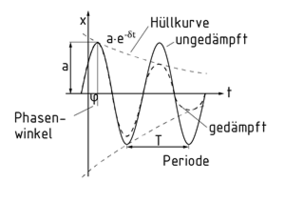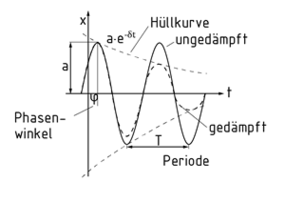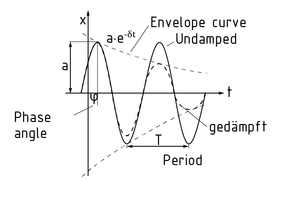
一种定义
四种语言
0,1,2
- 德國
- 英語
- 中國
- 西班牙語
自由振荡

如果一个物体被移开其平衡位置,之后也不对其施加外力,那么称该物体处于自由振荡状态。假设没有摩擦力的作用,那么该振荡处于无阻尼和自由的状态。
当物体在其平衡位置附近振动并受摩擦力的影响时,该振动处于自由但有阻尼状态。由于摩擦力的影响,该谐振荡的振幅 ${{y}_{\max }}$ 将逐渐减小。摩擦的影响可用两个指数衰减函数来表示。例如在扭转摆和线摆中存在这种类型的振荡。
U形管中的液体也可以做前后摆动的阻尼振荡。振荡介质的粘度对阻尼程度有很大影响。物质的粘度越高,阻尼效果越强。
以下是振荡的相关重要参数:频率f,振动周期T,振幅A和位相角 $\varphi $ 。
阻尼振荡和非阻尼振荡
Freie Schwingung

Wird ein Schwingkörper aus seiner Ruhelage ausgelenkt und anschließend nicht mehr auf ihn eingewirkt, so tritt eine freie Schwingung auf. Unterstellt man, dass keine Reibung vorliegt, so ist es eine ungedämpfte freie Schwingung.
Ein um seine Ruhelage schwingender Körper, auf dem Reibungseinflüsse wirken, vollführt eine gedämpfte freie Schwingung. Die Amplitude ${{y}_{\max }}$ der harmonisch verlaufenden Schwingung wird durch Reibungseinflüsse über die Zeit reduziert. Zwei abklingende e-Funktionen hüllen die Schwingungsfunktion ein. Diese Schwingungsform tritt zum Beispiel bei einem Dreh-, Torsions- oder bei einem Fadenpendel auf.
Auch eine sich in einem U-Rohr befindliche Flüssigkeit kann gedämpft hin und her schwingen. Die Viskosität des schwingenden Mediums hat dabei einen großen Einfluss auf die Stärke der Dämpfung. Eine hohe Viskosität hätte eine starke Dämpfung zur Folge.
Folgende wichtige Parameter sind bei einem Schwingungsvorgang relevant: Frequenz f, Periodendauer T, Amplitude A und Phasenwinkel $\varphi $.
Free oscillation

If an oscillating body is displaced from its position of rest and no Force is brought to bear on it thereafter, it is said to be oscillating freely. If we assume that no Friction is present, the Oscillation is both undamped and free.
When a body is swinging around its position of rest and is subject to friction influences, the oscillation is free but damped. The amplitude ${{y}_{\max }}$ of the harmonic oscillations is gradually reduced over time due to the effects of friction. Two exponential decay functions envelope the oscillation function. This type of oscillation occurs in the case of torsional and thread pendulums, for example.
A liquid in a U-shaped pipe can also swing back and forth in damped oscillation. The viscosity of the oscillating medium has a major influence on the extent of the damping. A high viscosity would have a strong Damping effect.
The following key parameters are relevant to oscillation: frequency f, period of duration T, amplitude A and phase angle $\varphi $.
Oscilación libre

Si un cuerpo en oscilación es desplazado de su posición de reposo y ninguna fuerza es aplicada sobre el mismo posteriormente, se dice que está oscilando libremente. Si asumimos que no hay fricción presente, la oscilación es no amortiguada y libre.
Cuando un cuerpo se balancea alrededor de su posición de reposo y se somete a las influencias de la fricción, la oscilación es libre pero amortiguada. La amplitud ${{y}_{\max }}$ de las oscilaciones armónicas se reduce gradualmente con el tiempo debido a los efectos de la fricción. Dos funciones de declinación exponencial envuelven a la función de oscilación. Este tipo de oscilación ocurre en el caso de los péndulos de torsión o de hilo, por ejemplo
Un líquido en un tubo en forma de U también se puede balancear ida y vuelta en una oscilación amortiguada. La viscosidad del medio oscilante tiene una influencia mayor en el grado de amortiguación. Una mayor viscosidad tendrá un efecto de amortiguación fuerte.
Los siguientes parámetros clave son relevantes a la oscilación: frecuencia f, periodo de duración T, amplitud A y ángulo de fase $\varphi $.
Oscilación amortiguada y no amortiguada
